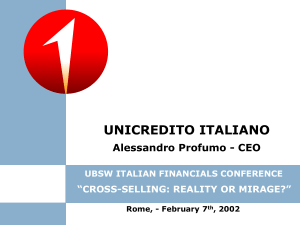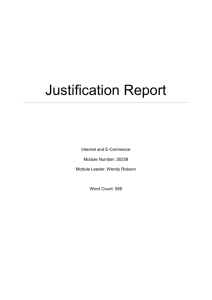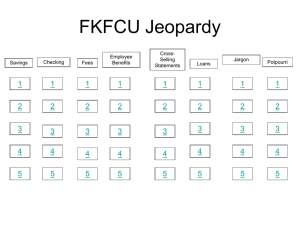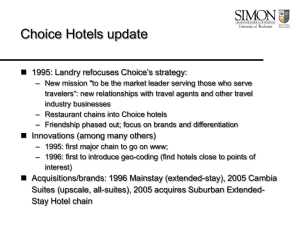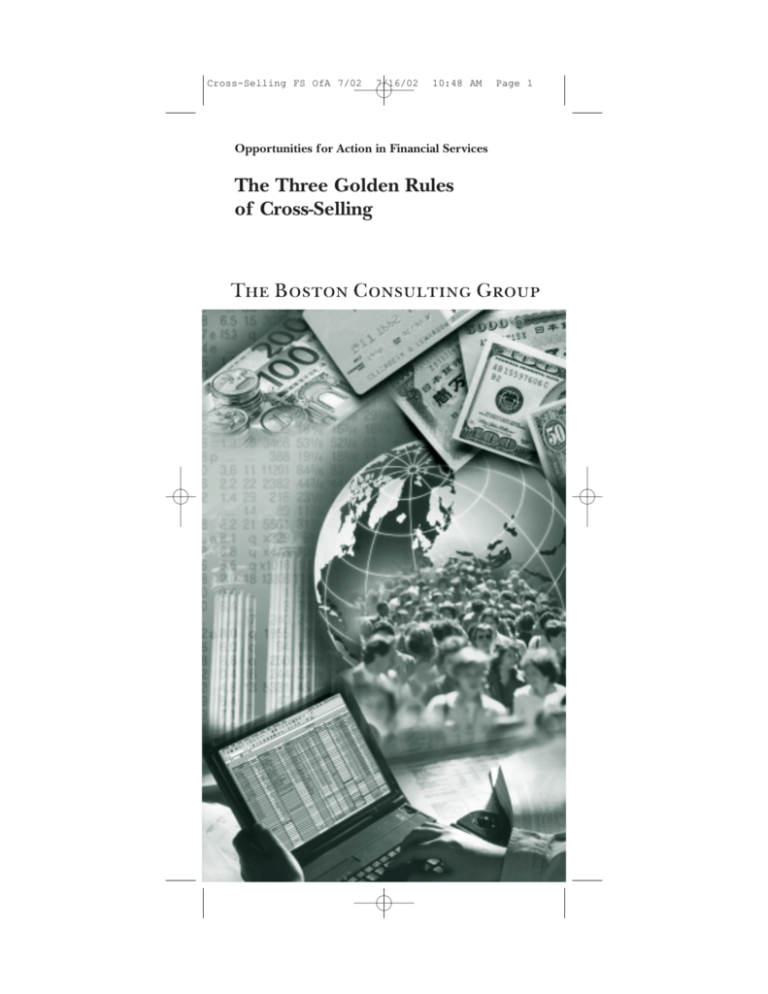
Cross-Selling FS OfA 7/02
7/16/02
10:48 AM
Opportunities for Action in Financial Services
The Three Golden Rules
of Cross-Selling
Page 1
Cross-Selling FS OfA 7/02
7/16/02
10:48 AM
Page 3
The Three Golden Rules
of Cross-Selling
Most banks and insurance companies recognize
the value to be captured from effective cross-selling.
Many have evolved into multiproduct, multichannel
companies, yet the typical retail customer still holds
only about two products, out of a possible eight or ten,
at any one institution. In both industries, revenue can
increase dramatically with the number of additional
products sold.
But good cross-selling, which also slashes customer
acquisition costs and enhances retention, has proved
to be an elusive grail in financial services, sought by
many but attained by few. A principal reason is that
too much of the sizable investment many firms have
put into improving cross-selling has gone toward technology-based solutions, such as customer-relationship
management systems and data warehouses. Initiatives
such as these, by themselves, are not sufficient to
bring about the needed change.
The Boston Consulting Group’s view is that the fundamental driver of cross-selling is getting the organization
right. This means designing structures, collaborative
networks, and incentives that powerfully and efficiently fuel the process. Such endeavors go hand in
hand with the basic tenets of sales force effectiveness.1
But having a design alone will not do the trick. It’s
the details that count, the nuances that actually guide
the behavior of your personnel.
1. See BCG’s Opportunities for Action in Financial Services, “Sales
Force Effectiveness: It’s Not About Playing, It’s About Winning,”
May 2002.
Cross-Selling FS OfA 7/02
7/16/02
10:48 AM
Page 4
BCG has identified three golden rules of cross-selling.
We call them Refer, Team, and Enable. Each rule can
also be thought of as an organizational model, to be
applied exclusively or in a mix, depending on the
nature of the product you are seeking to cross-sell,
how the customer buys, and the capabilities of your
sales force. In each model, there is a desired behavior
that needs to be inculcated in your sales staff.
Although behavioral change is never easy to bring
about, it can be achieved with creativity and a fresh
understanding of what makes today’s sales forces tick.
If management is committed, the three golden rules
can help solve cross-selling issues that vex many
financial services providers, and markedly improve
performance.
Rule 1: Refer
Referrals involve different areas of your institution
identifying leads and systematically passing them on
to other areas that are better positioned to pursue,
advance, or close a sale. Referrals are particularly useful when the aim is to cross-sell two distinct products
to the same customer, but when specific expertise or
special handling is needed.
The required behavioral change is that sellers consistently share high-quality leads with each other. That
may sound elementary, but CEOs know that in the
day-to-day reality of selling, it is anything but. Sellers
on one side can too easily say to themselves, “Why
bother? It’s my customer.” Banks and insurance companies can counter this tendency with financial incentives, but when such incentives fail, a different
approach is called for.
Cross-Selling FS OfA 7/02
7/16/02
10:48 AM
Page 5
A Structural Solution. Take the case of a leading
global financial institution that wanted to maximize
cross-selling between its investment banking division
and its wealth management division. There was no
value in offering the highly paid investment bankers
meager financial incentives to pass on leads. So the
bank decided on an organizational change: it created
a lead-management group to drive referrals from the
investment banking side to the wealth side. The
group reported to the wealth division, and was
charged with ensuring that the firm’s wealth management capabilities were highlighted in dealings with
IPO and M&A clients. It was also responsible for
drawing up corresponding lists of individuals who
might soon be seeking wealth management services.
This relatively simple move, plus management’s push
for a culture of strong collaboration—instilling the
idea that diligently passing on leads was good for the
firm, and therefore good for all sellers—helped bring
about the desired behavior and make this initiative
successful. In fact, the institution is now widely
regarded as the most successful investment bank in
working effectively with its private-client business.
The Multichannel Environment. As important as
organizing for effective cross-selling among products
is doing so among channels. This initiative also falls
under the “refer” mantle, since channels, in essence,
must refer each other to the customer. The goal is a
seamless experience in which the client can start a
transaction in one channel and complete it in
another, with each channel sharing information and
being fully aware of the pathways the client is taking.
The focus must be on smooth handoffs, since integrated channels (as opposed to silo-like entities working principally alone) are most effective in driving
Cross-Selling FS OfA 7/02
7/16/02
10:48 AM
Page 6
cross-selling. Such handoffs are facilitated in the same
way as in product cross-selling—through structures,
collaborative networks, and incentives.
For example, a customer who begins a mortgage
application online but quits halfway through should
not be abandoned. The next time he or she calls the
bank, the customer service representative should see
the unfinished business on his screen and suggest an
appointment with the relationship manager, who in
any event should follow up with a call to the customer. Through this type of cooperation, one major
bank recently turned roughly 10 percent of online
mortgage browsers into offline mortgage buyers.
The Group Retail Concept. Cross-selling between
institutions’ corporate and retail divisions is still at an
early stage in many markets. But some banks and
insurers are organizing for it with a structure that we
call the group retail concept. This involves a financial
institution partnering with a company, retailer, or
educational establishment, with an exclusive agreement through which information on employees, customers, or students is shared. The bank or insurer
serves both the institution and its captive customer
base, developing customized and preferential products for both.
This concept is spreading rapidly in financial services.
In Spain, for example, Bankinter has opened
branches at the offices of professional services
firms—and at other companies that employ a high
concentration of potentially desirable individual
clients—to make it easier to serve both the companies
and their staffs. This initiative has vastly improved
Bankinter’s cross-selling performance, helping it
achieve a current average of 6 products per client, up
from 2.5 products not long ago.
Cross-Selling FS OfA 7/02
7/16/02
10:48 AM
Page 7
Contractual arrangements can accomplish similar
goals. ABN AMRO’s pact to manage assets for LF
Insurance Group of Sweden includes the agreement
that ABN AMRO can distribute its mutual fund products to LF’s retail customer base.
The group retail concept represents a twist on the
“refer” model, in that it often involves a financial
services provider’s institutional partner referring its
associates back to the provider. That can be a powerful tool in cross-selling.
Rule 2: Team
Teams can be highly effective when a coordinated
cross-selling approach to the customer requires a specific mix of skills and products. But achieving the
desired collaboration depends on making key design
choices that reward collective effort.
One useful cross-selling model is teaming people
from different areas of the sales force to sell to each
other’s customers. For example, one multiline insurance company organized its life and nonlife businesses as separate units, each with its own sales staff
selling to the same customers—independent brokers.
But the firm was not leveraging its relationships or its
cross-selling opportunities with these brokers.
To improve performance, the firm organized interlocking teams in which each life salesperson worked
with multiple nonlife salespeople and vice versa. Each
client’s total portfolio was allocated to a single team.
This structure ensured that no salesperson was completely dependent on a single other person for performance. The company also targeted customer relationships in which either the life or the nonlife sales
Cross-Selling FS OfA 7/02
7/16/02
10:48 AM
Page 8
performance had previously been weak, and tightened its incentive policy so that no bonus rewards—
which could reach 200 percent of base pay—were
received until salespeople hit at least 75 percent of
their annual targets in all categories. These organizational initiatives led to much better cross-selling performance for the insurer.
Rule 3: Enable
The third golden rule requires salespeople to expand
their range and develop expertise in selling specialized products that have previously been outside their
domain. This places the emphasis firmly on matching
sales force capabilities with customers’ buying needs.
It also demands a significant behavioral change from
sellers.
One way to enable this type of cross-selling is to simplify the scope of the products offered. This was the
case with a leading European bancassurer whose aim
was to beef up insurance sales, and which had separate generalist (banking) and specialist (insurance)
sales forces. The generalists sold few insurance products, and the specialists liked selling insurance only to
the corporate segment, not the mass affluent segment
the firm wanted to target. Since the generalists had
no incentives to pass leads to the specialists, the overall result was very limited success in selling insurance
to the target customers.
To address the problem, the firm decided to align the
generalist sales force to sell insurance to the mass
affluent segment. It limited the insurance product
range that these sellers worked with, helping them
build some experience and confidence, and then simplified the products themselves to make them more
Cross-Selling FS OfA 7/02
7/16/02
10:48 AM
Page 9
readily salable in one session. The company also
implemented new incentives linked to insurance
sales, setting targets of two life policies and one nonlife policy per week for each generalist salesperson,
whose performance against these goals was made a
factor in career progress. These measures resulted in
markedly improved performance in selling insurance
to the mass affluent segment, and the firm outgrew
the market in total bancassurance revenues by more
than 50 percent over two years.
One caveat, of course, is that the customer is always
the ultimate judge. If the bancassurer’s mass affluent
customers had wanted more-complex products, the
generalist sales force would have lacked sufficient
training and this initiative might not have succeeded.
Clearly, product simplification is only part of the
enablement concept—institutions must also educate
sellers on how to address clients’ specific needs.
While many institutions have had little success in getting salespeople to expand their range in order to lift
cross-selling, the right combination of structural and
incentive-based steps can bring excellent results.
The Ground Is Fertile
Whether your immediate aim is to cross-sell between
products, channels, or segments, applying the three
golden rules—separately or in a mix—can raise revenues, increase retention, and cut expenses. One U.S.
bank, Wells Fargo, has shown that cross-selling to
existing customers can cost as little as 10 percent of
what it costs to acquire new clients. Overall, applying
the three golden rules can increase profits attributable to cross-selling by between 50 and 100 percent in
the near term.
Cross-Selling FS OfA 7/02
7/16/02
10:48 AM
Page 10
But different areas of your business must get into the
habit of referring leads and customers among themselves. Teams must learn to work together. And your
firm needs to develop product constellations and
training programs that truly encourage sellers to sell.
Finally, management must be strongly committed to
improving cross-selling performance. It is a challenging initiative, but great rewards can grow from this
very fertile ground.
Meanwhile, as you think about how your institution
can increase its cross-selling, keep these ideas in
mind:
• The key is to change sellers’ ingrained behavior.
• Organizational structures must be conducive to
that change, and management must be committed
to bringing it about.
• Incentives, based on chosen metrics and crossselling targets, can be a highly effective motivator
of the desired behavior.
• When incentives do not or cannot work, explore
structural solutions.
• Making collaboration and cross-selling performance criteria for career advancement gets sellers’
attention.
• Putting renewed focus on the capabilities of your
human resources, and on recruiting accordingly,
will pay off.
The most successful cross-selling firms, indeed, tend
to give the terms refer, team, and enable a new context.
They refer efficiently and consistently, which makes
Cross-Selling FS OfA 7/02
7/16/02
10:48 AM
Page 11
their entire sales staff feel like a team, which enables
the company to stay ahead of its rivals.
Such institutions are few, however. Could yours
become one of them?
Andrew Cainey
Frans Blom
Gunther Schwarz
Andrew Cainey is a vice president and director in the
Singapore office of The Boston Consulting Group. Frans
Blom is a vice president and director in the firm’s
Amsterdam office. Gunther Schwarz is a vice president
and director in BCG’s Cologne office.
You may contact the authors by e-mail at:
cainey.andrew@bcg.com
blom.frans@bcg.com
schwarz.gunther@bcg.com
© The Boston Consulting Group, Inc. 2002. All rights reserved.
Cross-Selling FS OfA 7/02
Amsterdam
Athens
Atlanta
Auckland
Bangkok
Barcelona
Beijing
Berlin
Boston
Brussels
Budapest
Buenos Aires
Chicago
Cologne
Copenhagen
Dallas
Düsseldorf
Frankfurt
Hamburg
7/16/02
Helsinki
Hong Kong
Istanbul
Jakarta
Kuala Lumpur
Lisbon
London
Los Angeles
Madrid
Melbourne
Mexico City
Milan
Monterrey
Moscow
Mumbai
Munich
New Delhi
New York
Oslo
10:48 AM
Paris
Rome
San Francisco
São Paulo
Seoul
Shanghai
Singapore
Stockholm
Stuttgart
Sydney
Tokyo
Toronto
Vienna
Warsaw
Washington
Zürich
BCG
www.bcg.com
07/02
Page 12


